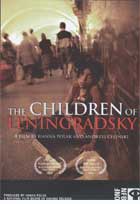
Children of Leningradsky 2004
Distributed by National Film Board of Canada, 1123 Broadway, Suite 307, New York, NY 10010; 800-542-2164
Produced by Hanna Polak and Andrei Celinski
Directed by Hanna Polak and Andrei Celinksi
DVD, color, 35 min., Russian with English subtitles
Sr. High - Adult
Ethnography, Anthropology, Sociology
Date Entered: 08/14/2007
Reviewed by Cindi Tysick, University at Buffalo Libraries, State University of New York at BuffaloAccording to the Russian Children’s Welfare Society “widespread domestic strife and unemployment are forcing an increasing amount of Russian children onto the streets. It is estimated, there are nearly 2 million homeless children in Russia, with upwards of 100,000 of them trying to survive in Moscow alone. The orphanages forced to accommodate an estimated 700,000 children face overcrowding and destitution, leaving many orphans to fend for themselves by means of begging, theft and prostitution. Though Moscow’s orphanages typically do not accept children from outside the capital, the city has nonetheless become host to legions of homeless youth from around the former Soviet Union.”
It is amid this reality that Hanna Polak and Andrei Celinski have captured the struggle between despair and hope that exists for the homeless children of Moscow’s Leningrad railway station. The children interviewed range in age from 8 to 14 years old. Each one has a similar story as to how they came to be homeless. Parents, abusive due to drug or alcohol addiction, looking to spend their money on themselves either kick their children out of the house or push them to run away. All of them come to Moscow expecting something better; better food, better shelter, better people. What they get are meals from a dumpster, homes made of burned out buildings or hot steam pipes, and pedophiles looking to score with the lure of a hot meal and shower.
This documentary is not easy to watch. You see children, who should be carefree, worrying about each other, finding enough to eat, and becoming addicts like their parents. In some cases they form loose families and eventually rough gangs. The families support each other when one is hurt or sad, the gangs roam the streets beating up the homeless and stealing their belongings. The ferocity with which children can turn from one to the other is disturbing. To think that a gentle 8 year old like Sasha will eventually become a violent criminal like 12 year old Roma breaks your heart. But that is the reality for many of these children.
What of society and the adults? As each scene plays out you see that many adults ignore or even push away these destitute children. Children sleep on the station’s dirty floor with outstretched hands while indifferent adults walk by. Some children carry around kittens and puppies (just as lost and abandoned as they are) not just for comfort but also to garner adult sympathy for the animal as they panhandle. Those who don’t panhandle, like 12 year old Tolya, often become prostitutes, terrified that their next trick will be their last. Many of the young prostitutes get AIDS or syphilis. Those who get pregnant feed into the vicious cycle by putting their babies in orphanages. Police are often these children’s worst enemies. Many, like 13 year old Losha, have been interrogated and beaten repeatedly by police. The little comfort or warmth the children get comes from a small meal and a few articles of clothing given to them by an aid group. Real life has dealt these children such a harsh hand that many escape it through drugs, alcohol, and sniffing glue. 13 year old Andriey and 14 year old Yura both recount how adamantly they pushed the glue away until eventually they gave up and embraced a habit that can be deadly, as witnessed by the overdose death of 14 year old Tanya.
Woven throughout the documentary are scenes of gentleness. You see children playing with “pets”, climbing statues, playing ball, laughing at life, and just being kids. But more often you are confronted with children singing lamenting songs for their mothers, crying because they lost out on a donated article of clothing, or despairing that they just want an education or to go home. Normally when children make rash, emotional mistakes it is the adults that pick up the pieces. These children have no competent adults to lean on or help them sort out the mess that is their lives. But in the end director Hanna Polak leaves the viewer with hope when 13 year old Misha states that “God loves everyone, but most of all the children”.
This DVD is highly recommended for senior high school to adult. It complements curriculum in social work, ethnography, social sciences, sociology, psychology, and social justice.
Awards: